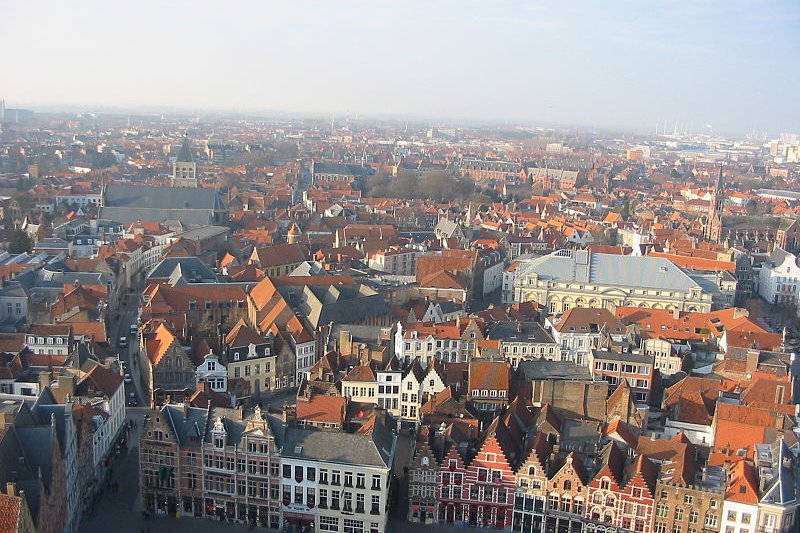 View of Bruges, Belgium, as seen from the belfry of its cathedral
View of Bruges, Belgium, as seen from the belfry of its cathedralSource: https://en.wikipedia.org/wiki/File:Bruges_view_from_the_belfry.JPG
Author: Donar Reiskoffer

Bruges (Dutch: Brugge) is the capital and biggest city of the province of West Flanders, in the Flemish Region of Belgium. Located in northwestern Belgium, Bruges covers 138.4 sq km and has a population of 117,000 (2011 estimate). The historic center of Bruges has been well preserved and is today recognised as a World Heritage Site.
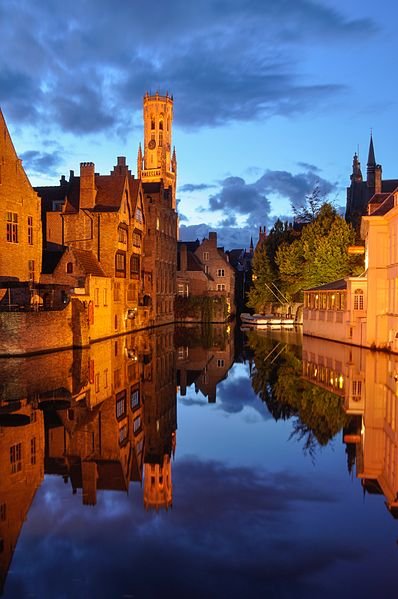 View of the Bruges Belfort from Rozenhoedkaai in Bruges, Belgium
View of the Bruges Belfort from Rozenhoedkaai in Bruges, BelgiumSource: https://commons.wikimedia.org/wiki/File:Bruegge_View_from_Rozenhoedkaai.jpg
Author: Arcalino

Bruges comprises the Historic City Center, along with Koolkerke, Sint-Andries, Sint-Michiels, Assebroek, Sint-Kruis, Dudzele and Lissewege.
As with Amsterdam, it has a network of canals, earning it also the title of Venice of the North. The city traces its history to the pre-Roman era, when the area was inhabited by Gauls. The Romans under Julius Caesar erected the earliest fortifications in Bruges to protect the trading port from raiders.
In the 4th century, the Franks captured Bruges from the Gallo-Romans. Raids staged by Vikings in the 9th century forced Count of Flanders Baldwin I to reinforce the Roman fortifications. Around this period, the earliest coins to bear the name Bryggia began to appear. It is believed that the name may have the same origin as the Old Norse name of Bryggja, from which we get the Norwegian city Bergen.
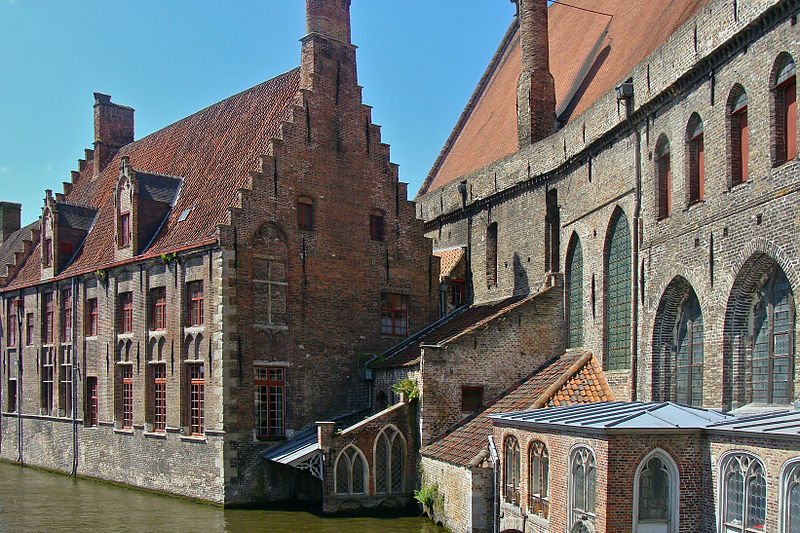 Historic buildings beside the canal in Old Bruges
Historic buildings beside the canal in Old BrugesSource: https://commons.wikimedia.org/wiki/File:Bruges_Ascension_2009037.JPG
Author: Jebulon

Visiting Bruges
Fly to Brussels or Lille, and then take a train to Bruges. The entire journey should take about an hour and 20 minutes. There's a train from Brussels to Bruges every 30 minutes. The train journey from Brussel-Zuid station to Bruges takes about an hour.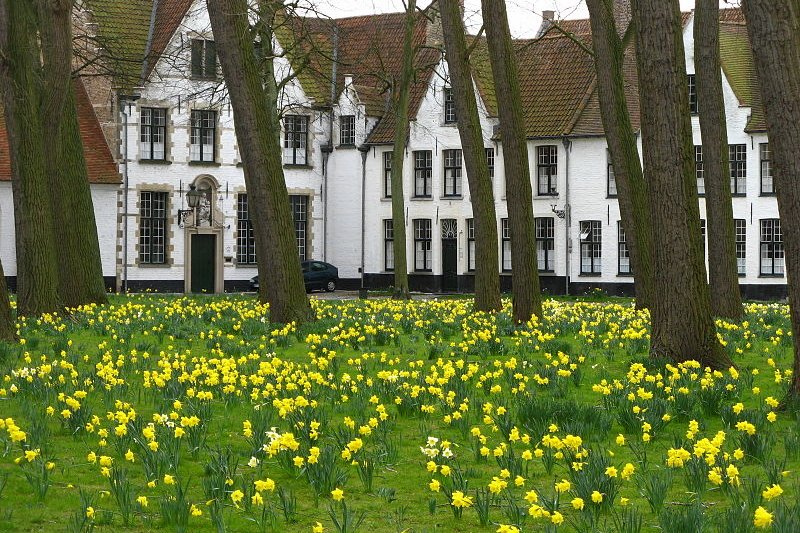 Begijnhof in Bruges
Begijnhof in BrugesSource: https://commons.wikimedia.org/wiki/File:20080301_Brugge_%28000%29.jpg
Author: Donar Reiskoffer

Places of Interest in Bruges
The Historic Center of Bruges can easily be explored on foot. There are also public buses operated by De Lijn, the transportation authority in the Flemish Region. In addition, you can rent bicycles to cycle about in the city.- Arentshuis
Arentshuis is an 18th century mansion overlooking the Dijver Canal. It today houses an annexe of Groeninge Museum, the main building located nearby. - Begijnhof
This is a beguine (for women who want to dedicate their lives to God without actually becoming nuns) founded by Margaret of Constantinople in 1244. Modern-day visitors can today enjoy the beauty of the quiet surroundings with its rustic furniture. - Belfort
This is an octagonal tower built between the 13th and 15th centuries. It stands at a height of 83 m (272 ft). There are 366 steps going up the tower. If you climb it, you will pass the chamber where the town's rights and privileges were stored. There is also the carillon, a set of 47 bells that can be played on a keyboard. - Markt (Bruges Market Square)
The market square is an open space lined with well-restored 17th century houses. Look for the Neo-Gothic Provincial Hof, built between 1881 and 1921. The statue of Pieter de Coninck and Jan breydel are in the middle of the square. - Burg
Burg is a cobbled stone squre behind the Market Square. This was once the political and religious focus of the city. It was named Burg, or fort, after the original fort around which the city grew. Located around the square today are the Stadhuis (town hall) and the Oude Griffie (Old Recorder's House), with the Renaissance Hall next door. - Choco-Story
Formerly a wine tavern, this is today a museum for chocolates. You will get to see, learn and of course taste chocolates here. Choco-Story provides the whole history of chocolates, from its origin in Central America. Also within the same building is Lumina Domestica. - Friet Museum
Founded by the same creators of Choco-Story, the Friet Museum celebrates the Belgium fries. You get to learn everything you wish to know (and more) about how fries are made, from the choice of potatoes, its history, how it is cut, and more. - Groeninge Museum
This is the top fine-arts museum in Belgium. It has a fabulous collection of works by Flemish and Dutch masters. The museum is housed in two different buildings. The main portion showcases works by early Flemish masters as well as works of different styles from the 17th to 20th centuries. Across the approach road is Arentshuis, with more exhibits. - Gruuthuse Museum
This museum has an outstanding collection of fine and applied arts. It is housed in a large medieval mansion near the Dijver Canal. The house once belonged to a merchant in the 15th century. - Heilig Bloed Basiliek
The Basilica of the Holy Blood is one of the most important Catholic churches in Bruges. It holds one of the most sacred reliquaries in Europe., a phial supposed to cantain a few drops of blood and water washed from the body of Christ by Joseph of Arimathea. - Lumina Domestica
This is a museum of domestic lighting. It has an exquisite collection of some 6,500 lamps from various periods in history. - Minnewater
This is a park with lake in Bruges. There are swans here since 1488, when Maximilian of Austria have them kept here, in memory of his councillor, Pierre Lanchals, who was beheaded by the people of Bruges. - Onthaalkerk Onze-Lieve-Vrouw
Literally the "Welcome Church of Our Lady", this Catholic church as a 122-m (400 ft) spire, one of the tallest in Belgium. Its history dates back to 1220. Its interior is a picture of medieval simplicity. - St-Janhospitaal and Hans Memling Museum
Once a hospital that operated from the 12th century until 1975, this is today a museum. It showcases two different items: the medieval medical hospital, with its antique beds and medical instruments, and the paintings by the famous German-born painter, Hans Memling, who created many paintings for the hospital. - St-Salvatorkathedraal
Originally built in the 12th century as a parish church, this structure was enlarged over the centuries, and became Bruges's cathedral in 1834, after the Cathedral of St Donation at the Burg was destroyed. - Stadhuis
This is the Town Hall of Bruges. It has an intricately carved façade that was done in 1375. In the niches are statues of counts and countesses - they were made much later. Inside you can see the magnificent Gothic Hall, built around 1400. The whole building is an example of successful restoration. - Vismarkt
This is the fish market. A charming little path, called Blinde Ezelstraat ("Alley of the Blind Donkey"), connects it with the Burg.
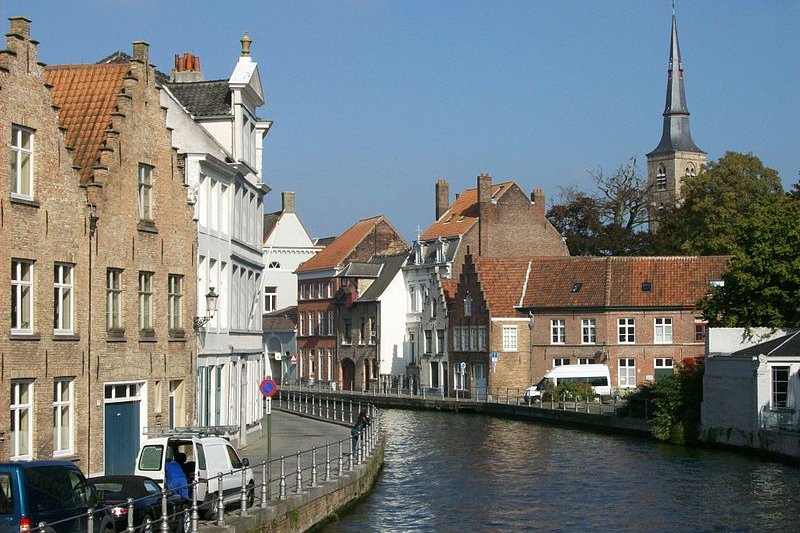 A canal at Molenbrug, Bruges
A canal at Molenbrug, BrugesSource: https://commons.wikimedia.org/wiki/File:View_from_Molenbrug,_Brugge_.jpg
Author: Tony Grist

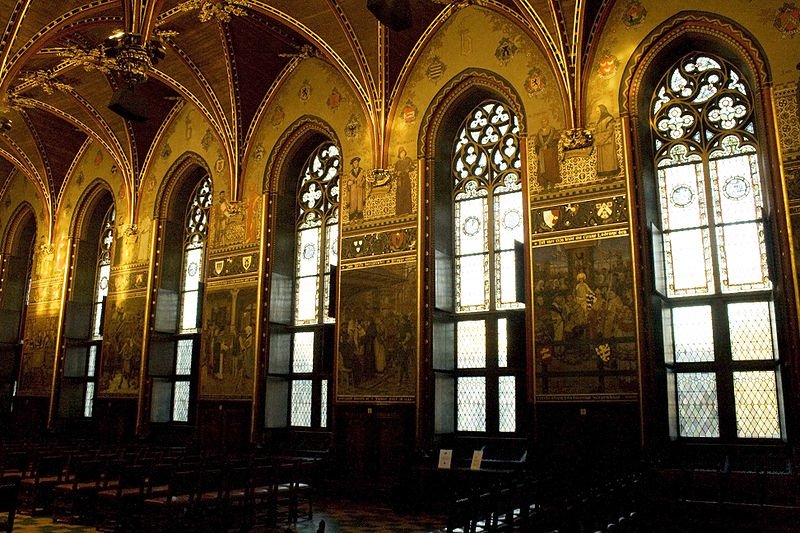 The Gothic Hall within the Stadhuis of Bruges
The Gothic Hall within the Stadhuis of BrugesSource: https://commons.wikimedia.org/wiki/File:Gothic_Hall_-_northern_wall.jpg
Author: Szilas

Sights & Attractions in Eastern Bruges
The area to the east of the Markt gets fewer visitors, but also has a number of sights worth visiting if you have the opportunity.- Guido Gezellemuseum
This is the house where the famous Flemish poet Guido Gezelle grew up. The rooms have been furnished in the period style to evoke the modest circumstances of his upbringing. - Jeruzalemkerk
This is one of the more unusual churches in Bruges. It was modelled after the Church of the Holy Sepulchre in Jerusalem. The present structure dates from the 15th century. It was commissioned by a rich Italian merchant couple, Anselmus Adornes and his wife. - Kantcentrum
This is a center that showcases the art of lace making. It is housed in 14th century almshouses next to Jeruzalemkerk, in a neighborhood famous for its lace making. - Kruispoort
This is one of the medieval gate to Bruges. Built in 1402, it guards the eastern approach to the city. On the eastern bank was once the old city wall. There were 20 windmills here, of which only four remains today. - Museum Onze-Lieve-Vrouw-ter-Potterie
Literally the Museum of Our Lady of the Pottery, this museum preserves the rustic appearance of a quiet part of Bruges. It was originally a hospital founded in 1276 to look after elderly women. - Schuttersgilde St-Sebastian
Literally the "Longbow Archers' Guild", this was a guild for the military archers during medieval times. It named itself after an early Christian martyr who was sentenced by Roman Emperor Diocletian to be executed by archers. St. Sebastian's wounds healed immediately, and he had to be re-executed usings clubs.
 Latest updates on Penang Travel Tips
Latest updates on Penang Travel Tips
 Discover with Timothy YouTube Channel
Discover with Timothy YouTube Channel
 PG Food Channel
PG Food Channel
 Learn Penang Hokkien YouTube Channel
Learn Penang Hokkien YouTube Channel
 SojiMart Videos
SojiMart Videos
Latest from Discover with Timothy: Gurney Bay - what to see and do there
About this website

Hello and thanks for reading this page. My name is Timothy and my hobby is in describing places so that I can share the information with the general public. My website has become the go to site for a lot of people including students, teachers, journalists, etc. whenever they seek information on places, particularly those in Malaysia and Singapore. I have been doing this since 5 January 2003, for over twenty years already. You can read about me at Discover Timothy. By now I have compiled information on thousands of places, mostly in Peninsular Malaysia and Singapore, and I continue to add more almost every day. My goal is to describe every street in every town in Malaysia and Singapore.
Robbie's Roadmap
- Episode 1: Robbie's Journey to Financial Freedom
- Episode 2: Lost in America
- Episode 3: The Value of Money
- Episode 4: The Mentor
- Episode 5: The Thing that Makes Money
- Episode 6: The walk with a Billionaire
- Episode 7: The Financial Freedom Awakening
- Episode 8: Meet Mr Washington
- Episode 9: The Pizzeria Incident
Copyright © 2003-2024 Timothy Tye. All Rights Reserved.


 Go Back
Go Back